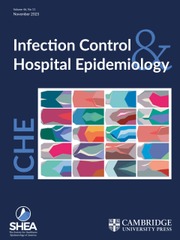Article contents
Clinical characteristics associated with hospital-onset bacteremia and fungemia among cancer and transplant patients
Published online by Cambridge University Press: 23 October 2024
Abstract
This study quantified the burden of hospital-onset bacteremia and fungemia (HOB) among cancer and transplant patients compared to other patients.
A retrospective cross-sectional study used data from 41 hospitals between October 2015 and June 2019. Hospitalizations were segmented into categories using diagnosis-related groups (DRG): myeloproliferative (MP) cancer, solid tumor cancer, transplant, and non-cancer/non-transplant (“reference group”). To quantify the association between DRG and HOB, multivariable adjusted Poisson regression models were fit. Analyses were stratified by length of stay (LOS).
Of 645,315 patients, 59% were female and the majority 41 years of age or older (76%). Hospitalizations with MP cancer and transplant demonstrated higher HOB burden compared to the reference group, regardless of LOS category. For all hospitalizations, the >30 days LOS category had a higher burden of HOB. The median time to reportable HOB was within 30 days regardless of duration of hospitalization (reference, 8 days; solid tumor cancer, 8 days; transplant, 12 days; MP cancer, 13 days).
MP cancer and transplant patients had a higher burden of HOB compared to other hospitalized patients regardless of LOS. Whether these infections are preventable should be further evaluated to inform quality metrics involving reportable bacteremia and fungemia.
- Type
- Original Article
- Information
- Copyright
- © The Author(s), 2024. Published by Cambridge University Press on behalf of The Society for Healthcare Epidemiology of America
References
- 1
- Cited by



